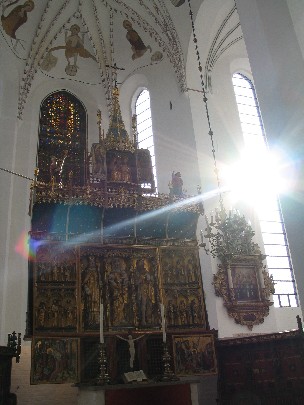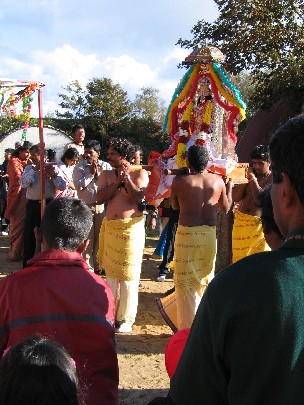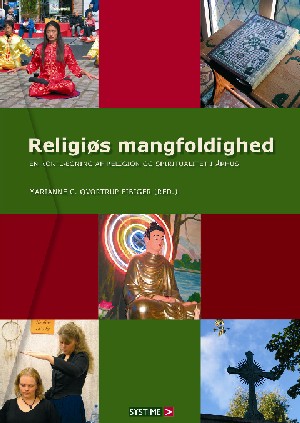| Religious pluralism on the research agenda | The birth and development of religious pluralism in Denmark |
| Today's religious market place | Contact |
As a focal point in academic and public debate, religious pluralism - and multireligiosity, its most obvious effect - is a recent phenomenon. But historically, most countries have accommodated aspects of religious pluralism within their religious practice, some way or other. Buddhism, for instance, almost always coexisted with other religious traditions wherever it flourished, and still does. If religious pluralism is interpreted as a fact only when all religions are allowed exactly the same life conditions in a certain society, it is an open question whether such a society exists; perhaps the American society is its closest equivalent.
Another feature of religious pluralism, however, is present in several Non-western societies because their religious life is characterised by a structure of individuals, typically affiliated with more than one religion. In other words: for the benefit of his or her religious belief and practice, the individual receives the services of various religious organisations and specialists according to specific purposes of his or her own choice. As an example, this structure is operative in Japan.
In our capacity as researchers of religion and theology at the University of Aarhus, religious pluralism as a key term for post-modern religious life became an obvious challenge to respond to, and therefore we have set up a research project. In order to get a qualified view of the impact (or lack of impact) of religious pluralism, it is important to deal with religious pluralism on a local, national, and a global level. Not least on the global level, a network of the highest standard is necessary. The Network for the Study of Religion in Contemporary Europe (NetSoRCE) is our European network, and furthermore, we are an affiliate of the American Pluralism Project of Harvard University. Concerning our working agenda, the main tasks consists of the mapping of religiosity and spirituality for the areas in question, followed up by analysis and interpretations, as part of interdisciplinary research.
To introduce our national level, Denmark: Christianity, in terms of Roman Catholicism, and – after the Reformation in 1536 – The Evangelical Lutheran Church, has been predominant in her entire historical existence. The latter achieved status as the Danish National Church, and, in this capacity, it is supported by the state, according to our National Constitution.
 |
| The Dome of Aarhus is the most magnificent symbol of the long history – and continued predominance – of Christianity in this city. Photo: René Dybdal Pedersen |
The Danish Constitution originated in 1849 (latest revision in 1953), and gave at the same time formal birth to religious pluralism in Denmark. It guaranteed religious liberty, and the rights of religious groups to organise and develop in their own way. At the same time it gave protection against potential persecution from the authorities and the civil society.
Looking at the present situation, we are at one level witnessing the remarkable concentration on the individual as the central agent of social structure, and at another level we experience globalisation flourish through the means of the market, technology, communication, and migration. In the light of these trends, one may put the question: What happens within the religious field?
First of all, The Evangelical Lutheran Church in Denmark (the national church) is thriving, and – numerically, at least – rather well, although a slight reduction of membership figures has been witnessed during the post-war period. In the same period, a growing number of alternatives have appeared. Various religious traditions, a major part featuring Islamic teachings, appeared through immigrants from the Middle East in particular, since the 1960s.
| Hinduism became influential in Denmark through two different sources: One responded to the growing interest in aspects of Hinduism, which followed the youth culture during the 1960s and 70s; and the other source consisted of immigrants from India, and Tamils from Sri Lanka, especially, who established Hindu communities in Denmark. The Sithy Vinaykar Temple in Herning is a central place of worship for the Sri Lankan Tamils in Jutland, and the procession outside it is a part of the celebrative events of the community. Photo: Marianne Qvortrup Fibiger |  |
Simultaneously, as the immigration wave began in the late 1960’s, new religious and spiritual groups, nurtured by alternative youth groups, yoga, meditation, and a variety of charismatic leaders, spread rapidly. This development echoed a similar trend in other Western countries and on the global level, individualisation grew more and more. Gradually, the choice of the individual became the main factor for the existence and prosperity for these groups, and their activities thus became their main attraction. This has created religious diversity, but most groups are small in size, upheld by only few core members. It is, however, important to note that the rather weak religious bodies and few core members maintain an impressive religious environment. In this process they are supported by different means of communication, which include education, mass media, Internet, holistic and mysticism festivals, and cross cultural activities though travels and migration. Therefore, we now and again find religion and spirituality as favoured discussion subjects among the Danes.
 |
| As a term, New Age is often used to summarize aspects of modern religiosity with common features. Within New Age, spirituality is the central value, and it stands for the development of the individual as a spiritual being, i.e. connected with the spiritual world in microcosm – macrocosm relations. Annual Festivals for Mind, Body & Spirit in Copenhagen, Aarhus – and other Danish cities, occasionally – serve as essential New Age forums. They gather specialists as well as people with a strong or plain curiosity. In recent years, also Mysticism Festivals have taken place in both cities. The photo from the Festival for Mind, Body & Spirit in Aarhus in 2003, introduces us to the Summit Lighthouse, a religion of theosophical observance. New Age is incorporated in the empirical material of the Danish Pluralism Project through the categories dealing with new spiritual and religious groups, and alternative medicine and spirituality. Photo: René Dybdal Pedersen |
 |
| The Danish Pluralism Project began its activities in 2001, and a research grant from the Danish Research Council for the Humanities, enabled a research period for three years. The initial stage of the project has just been concluded: the religious mapping of the municipality of Aarhus, covering the second largest city in Denmark with a total of about 280,000 residents. The project team consists of researchers of religion and theology who organised the inquiry, and a group of MA candidates and students doing interviews, participant observations, and providing background information. The conclusions of their shared efforts are available through the volume titled “ Religiøs Mangfoldighed ” (Religious Diversity). |
See also Project Update and Original Project Description.
Back to the start of Project Description – or the Pluralism Project Presentation
Back to Centre for Multireligious Studies Presentation
We are very much interested in cooperation and in sharing insights and would highly appreciate any news from anyone dealing with research projects similar to ours. On behalf of the team of researchers
Viggo Mortensen | Marianne Qvortrup Fibiger Research Coordinator, Associate professor, Department of the Study of Religion The Faculty of Theology, University of Aarhus, Building 443, DK 8000 Aarhus C, Denmark mf@teo.au.dk http://www.teo.au.dk Tel. +45 8942 6718 |